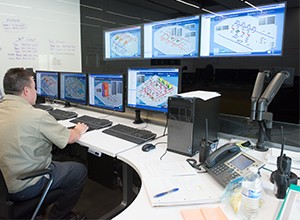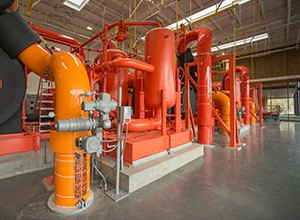Stanford is addressing climate change, the greatest environmental and socioeconomic challenge of our time, head on by raising the bar in efficiency and ingenuity in developing global solutions and implementing them across its 8,180-acre campus. In December 2011, Stanford’s Board of Trustees approved the Stanford Energy System Innovations (SESI) project, designed to meet the university’s future energy needs while reducing greenhouse gas (GHG) emissions and water consumption. SESI is the largest component of Stanford’s Energy and Climate Plan, originally developed in 2009, which also includes high efficiency standards for new buildings and continued efficiency improvements for existing buildings. The SESI project encompasses the best of both North American and European district heating and cooling system advances, with engineers, manufacturers, and builders from both continents collaborating to develop this state-of-the-art transformation of Stanford into one of the most efficient district energy systems in the world.
Conceived in the Department of Sustainability and Energy Management (SEM) and implemented in collaboration with the Department of Project Management (DPM), the university architect’s office, Land Use and Environmental Planning, Zones Management, Buildings and Grounds Maintenance, and many other departments, the SESI program is an all-hands Land, Buildings & Real Estate engagement that will deliver immense benefits for Stanford University in decades to come.

The control room of the CEF
Although developed independently by Stanford from 2009 to 2011, SESI may be the first large-scale example in the world of the
technology roadmap for building heating and cooling recommended by the International Energy Agency, which the United Nations Environment Programme discussed in a
comprehensive report on district-level implementation.
Results
This new system, along with Stanford’s renewable power procurement, is anticipated to reduce campus emissions approximately 68% and campus potable water use 15% from current levels.
Specific benefits of the SESI program include the following:
- The electricity-dependent energy supply system offers greater reliability, lower cost, and more flexibility for additional green power procurement. By the end of 2016, Stanford will procure 65% of its electricity from renewable sources.
- Because of the significant opportunity for heat recovery and the lower line losses of hot water compared to steam piping, the new energy system is 70% more efficient than the combined heat and power process of the cogeneration facility.
- Since the majority of the waste heat from the chilled water loop will be reused, rather than discharged via evaporative cooling towers, the Central Energy Facility (CEF) will use 115 million fewer gallons of water annually than the cogeneration plant, for total campus potable water savings of 15%.
- The $485 million capital investment for SESI represents a significant transformation of the university energy supply from fossil-fuel-based cogeneration to a more efficient electric heat recovery system. The SESI project provided the best-cost option compared to continuation of the cogeneration system, with a net additional $100 million capital investment projected to yield $420 million in savings over the next 35 years.

Heat recovery chillers at the CEF
Because there is a large overlap between campus heating and cooling demands, the new CEF utilizes an innovative heat recovery design that is significantly more efficient than the previous cogeneration process. Chilled water is sent out to campus for cooling needs and returns at a warmer temperature via a chilled water loop. Heat recovery chillers at the facility extract this excess heat collected from buildings for reuse in a new hot water loop, which replaced Stanford’s aging steam system. This new process not only is safer and reduces heat loss from the steam system, but also minimizes the need for conventional chillers to discharge waste heat via cooling towers.
The plant features both hot and cold water thermal storage and relies on a diversified mix of electricity sources for power to create a more environmentally and economically sound power portfolio, in stark contrast to the cogeneration plant, which relied on 100% natural gas. SEM operates the CEF with a new automated control system, Energy Optimization Solution (EOS), a patented technology invented at Stanford and developed for commercial use by Johnson Controls, Inc. EOS assures optimal operation through predictive economic dispatching based on load and market electricity pricing forecasts. It allows for fully automated operation to eliminate guesswork by plant operators in running a complex combined heating and cooling system with both hot and cold thermal storage, and has shown to increase efficiency an average of 6%.
Implementation
Implementation of the SESI program involved significant work throughout the campus between 2012 and 2015. DPM managed design and construction of 22 miles of low-temperature hot water pipe, conversion of the mechanical systems of 155 buildings to receive hot water instead of steam, and installation of the new CEF and high-voltage substation.

The CEF courtyard
The work was carefully sequenced in multiple phases to minimize disruption to campus life. As each phase of piping and building conversion reached completion, that section of campus moved off steam to hot water via a regional heat exchanger that converted steam from the cogeneration plant to hot water at a district level. A full transition from the cogeneration plant to the new CEF took place in April 2015, the regional heat exchange stations were removed, and the cogeneration plant was decommissioned to make way for new academic buildings within the campus core. Throughout the process, the
SESI website presented detailed project updates. It now showcases videos, fact sheets, and related articles that can help guide others on the path to efficiency.
Academic Integration
The Energy and Climate Plan, which set the framework for SESI, incorporated various faculty peer reviews from inception through approval. The first faculty GHG task force convened in 2009 to review the initial plan. Throughout 2011, the heat recovery scheme and proposed financial models were extensively peer reviewed by faculty from the School of Engineering and the Graduate School of Business, as well as a Board of Trustees advisory committee. SESI program studies have also periodically engaged graduate student researchers to supplement industry findings, verify models, and assist with other assessments. SEM partnered with the Stanford Solar and Wind Energy Project, a student group, to study the campus’s solar potential. The students assisted in analyzing data while gaining practical hands-on experience.
Stanford staff will continue to partner with students and faculty to utilize the CEF as a living laboratory, where students can directly interact with the technical operations of the university. To this end, Office of Sustainability offers weekly tours for all those interested in learning more about the SESI project, and it hosted its annual Earth Day celebration, Celebrating Sustainability, at the plant to debut the facility to campus. The CEF features communal space for classes and meetings for both Stanford students and members of the surrounding community. By helping educate tomorrow’s workforce, SESI is ensuring that these trained professionals can meet the demands of the world’s growing clean energy sector.

Gathering in the CEF courtyard
Looking Ahead
Implementation is under way of a project that will install photovoltaic panels on the rooftops of 18 campus buildings and a parking structure. Phase 2 studies of additional potential major enhancements to the campus energy system have begun. These include:
- Development of a ground source heat exchange system to complement the core heat recovery process;
- Installation of a new high-voltage transmission line to improve the reliability of the grid that serves the university;
- Installation of a plug-in electric vehicle infrastructure to support both private and university electric vehicles and electrification of the Stanford bus, truck, and car fleet; and
- Installation of a natural gas–based centralized emergency generation and distributed electrical storage system to replace the current distributed diesel fuel emergency generation system.
Detailed feasibility studies of these potential enhancements are under way and will be completed within the next few months.




